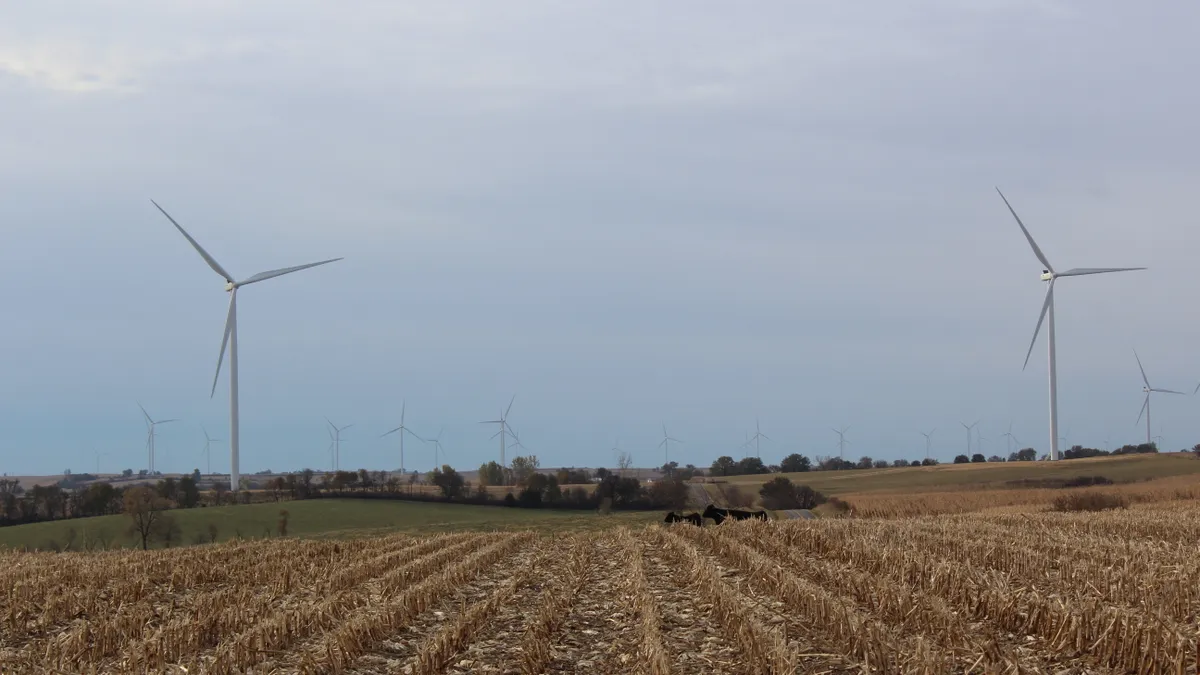Dive Brief:
- Corporate buyers of renewable energy will drive the development of 44 GW to 72 GW of new wind and solar projects in the United States over the next decade, according to research published Tuesday by IHS Markit.
- IHS found corporate-driven power purchase agreements (PPAs) could represent 20% of all utility scale renewable power additions from 2021 to 2030.
- Simultaneously, PPA offer prices "are on the rise for both wind and solar projects" according to new research from LevelTen Energy. The firm says its P25 solar index, which shows the 25th percentile of solar prices, has shown prices rising over the last six months, while wind prices have been trending upward for the past two years and are now higher than solar.
Dive Insight:
Corporate interest in renewable energy has never been higher, and particularly in the United States the trend is helping drive the development of wind and solar additions. But there are indications that prices are beginning to rise as tax incentives roll off.
"We have now reached a tipping point for corporate sector demand for renewables," Anna Shpitsberg, director of global power and renewables at IHS Markit, said in a statement.
IHS' new report concludes corporate-driven PPAs could drive development of 4.4 GW to 7.2 GW annually, "depending on the extent to which corporations expand and fulfill their renewable ambitions."
"Fueled by shareholder and consumer activism, the opportunity to hedge power costs and corporate renewable targets, companies are increasingly making the connection between a specific project and a specific facility's power demand," Shpitsberg said.
At the same time, there are indications that prices are on the rise.
LevelTen's P25 solar index has risen for the past two quarters and now sits at $29.30/MWh, surpassing its previous high of $29.20/MWh, recorded in the third quarter of 2018.
The P25 index of wind prices jumped 9% in the last quarter to a new high of $30.60/MWh. According to LevelTen, 2020 is the first time the wind index has risen above solar.
The report notes that over the past two years, the P25 index for wind PPA offer prices has risen in every independent service operator market, largely due to the step down in production tax credits (PTC).
Wind developers "got a bit of relief" at the end of 2019, said Rob Collier, vice president of developer relations at LevelTen, in a statement, when Congress extended PTC eligibility to wind projects that started construction in 2020. Projects got more help this spring when the Internal Revenue Service, as part of COVID-19 relief, extended some wind deadlines.
"Even so, the number of 100% and 80% PTC-eligible projects that are still available for PPA contracting is dwindling," said Collier. "With lower PTC eligibility, developers must make up project revenues in their PPA prices."
Rising demand for renewable energy is also having a price impact, particularly in areas where supply can't keep up. LevelTen research points to "grid connection delays" and "permitting challenges" as holding back some projects. Where demand outpaces supply, LevelTen's research survey found 73% of respondents anticipate that PPA prices will increase.
"Despite these increases, we want to underscore that we still see wind, and renewables in general, as being the most competitive form of generation for the future," Collier said.
Higher prices are unlikely to tamp down corporate demand for renewables, according to both IHS and LevelTen research.
IHS notes "more than any other country, the United States has a growing portion of new renewable energy projects being built to meet demand coming directly from corporations." More than 200 companies operating in the United States are already procuring renewables or plan to do so, the firm noted. "And about 40% of these companies have targets that escalate through the early to mid-2020s."
"The universe of corporations seeking clean energy continues to expand," BloombergNEF senior associate of corporate sustainability Kyle Harrison said in a statement.
Commenting on the LevelTen research, Harrison said more than 1,000 companies have now committed to setting science-based targets to reduce emissions.
"Investors and asset managers are setting portfolio decarbonization targets of their own," said Harrison. "There's a huge opportunity for developers to meet the needs of these buyers in the coming years."














